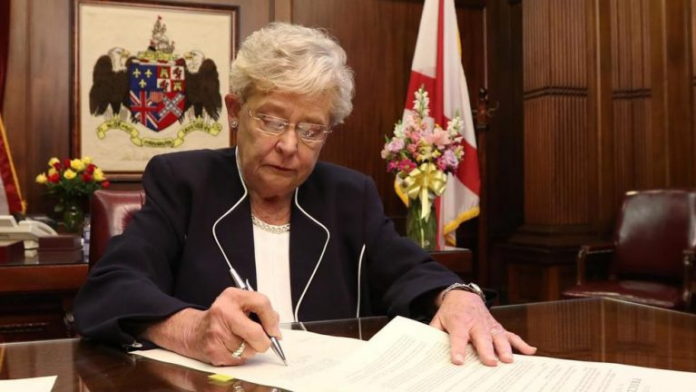MONTGOMERY, Ala. – Gov. Kay Ivey on Friday declared a new state of emergency as COVID-related hospitalizations approached the peaks of the first wave of the pandemic. She noted the end of the previous emergency declaration just a few weeks ago, but said that a new declaration must be made in light of current rises in hospitalization rates.
Ivey quoted the previous emergency’s termination notice in the new proclamation, noting that she had said “although the pandemic is not over, our healthcare systems are better equipped to treat the COVID-19 virus, and effective vaccines are readily available,” but then added, “in the approximately five weeks since the termination of the original COVID-19 public health emergency, COVID-19-related hospitalizations in Alabama have climbed from 235 (as of July 6, 2021) to 2,441 (as of August 12, 2021) – more than 10 times as many,” and “the current number of COVID-19-related hospitalizations is quickly approaching the record number of COVID-19-related hospitalizations in Alabama of 3,084, recorded on January 11, 2021.”
According to the proclamation, “as of August 12, 2021, 95 percent of beds in intensive care units in Alabama hospitals were occupied, resulting in the lowest ICU-bed availability since the beginning of the COVID-19 pandemic,” and “State Health Officer Scott Harris on August 12, 2021, warned that current hospitalizations in Alabama could surpass the record set in January 2021 by next week, and that the steep rise in COVID-19 cases has put ‘extreme stress’ on Alabama hospitals.”
The proclamation expands the possible job functions of various healthcare workers to provide a broader range of care, as long as the task assigned to a medical professional falls within that person’s training or experience. It also relaxes the rules for temporary licensure of traveling medical professionals from other states, as long as they have valid licenses in their home states.
The State will allow temporary changes to its typical Certificate of Need regulations, to allow hospitals to create or free up more bed space to house increasing numbers of patients. Temporary changes to Standard of Care regulations will allow for “Alternative Standards of Care” while still providing for a degree of care consistent with established regulations.
The State will once again allow the public meetings of government agencies to take place via video or other means, as long as the public has real-time access to those means and can participate in those meetings as they could at in-person meetings.
According to the proclamation, those transporting necessary equipment can carry larger and heavier loads, and may work longer hours than normally allowed. In order to expedite the purchase of that equipment, the public bid process is also temporarily modified to allow fast purchases. State employees who must travel as part of the new round of COVID response will be reimbursed for their expenses.
Ivey concluded by declaring the priority of the declaration over any provision of state law with which it might conflict. She did not set a termination date, saying that the state of emergency “shall remain in full force and effect for the duration of the public health emergency unless rescinded or extended by proclamation.”
Text of the proclamation
WHEREAS the Alabama Emergency Management Act of 1955, as amended, upon the Governor the power to proclaim a state of emergency when a public confers health emergency has occurred or is reasonably anticipated in the immediate future, see Ala. Code § 31-9-8;
WHEREAS I originally issued an emergency proclamation with respect to COVID-19 on March 13, 2020, and supplemental emergency proclamations to further address the occurrence of COVID-19 in the State of Alabama on the following dates: March 18, 20, 23, and 26 of 2020; April 2, 3, and 13 of 2020; May 8 and 21 of 2020; June 9 and 30 of 2020; July 2, 15, and 29 of 2020; August 21 and 27 of 2020; September 30, 2020; November 5, 2020; December 9 and 11 of 2020; January 21, 2021; March 4, 12, and 22 of 2021; April 7, 2021; and May 3, 2021;
WHEREAS, on July 6, 2021, I issued a proclamation terminating the public health emergency, noting that “although the pandemic is not over, our healthcare systems are better equipped to treat the COVID-19 virus, and effective vaccines are readily available;”
WHEREAS, in the approximately five weeks since the termination of the original COVID-19 public health emergency, COVID-19-related hospitalizations in Alabama have climbed from 235 (as of July 6, 2021) to 2,441 (as of August 12, 2021) – more than 10 times as many
WHEREAS the current number of COVID-19-related hospitalizations is quickly approaching the record number of COVID-19-related hospitalizations in Alabama of 3,084, recorded on January 11, 2021,
WHEREAS, as of August 12, 2021, 95 percent of beds in intensive care units in Alabama hospitals were occupied, resulting in the lowest ICU-bed availability since the beginning of the COVID-19 pandemic;
WHEREAS State Health Officer Scott Harris on August 12, 2021, warned that current hospitalizations in Alabama could surpass the record set in January 2021 by next week, and that the steep rise in COVID-19 cases has put “extreme stress” on Alabama hospitals; and
WHEREAS the COVID-19 virus persists in Alabama and the nation, and it continues to present a serious threat to public health, taxing Alabama hospitals, many of whom were already struggling to staff their facilities;
NOW, THEREFORE, I, Kay Ivey, Governor of the State of Alabama, on the recommendation of the State Health Officer and pursuant to relevant provisions of the Alabama Emergency Management Act of 1955, as amended, Ala. Code §§ 31-9-1 et seq., do hereby declare that a state public health emergency exists in the State of Alabama for the disease referenced as “COVID-19” in my March 13, 2020 proclamation and which reference has and continues to include all existing and future variants, mutations, and forms of the virus (SARS-CoV-2) throughout this pandemic, as well as all existing or future variants, mutations, or forms of COVID-19 that are not considered to have been included in that reference, if any. I direct the appropriate state agencies to exercise their statutory and regulatory authority to assist the communities and entities affected. I also direct the Alabama Department of Public Health and the Alabama Emergency Management Agency to seek federal assistance as may be available and appropriate.
FURTHER, I hereby proclaim and direct all of the following:
I. Cutting red tape for healthcare providers
To accommodate surging numbers of COVID-19 patients requiring treatment in hospitals, I find that it would promote the safety and protection of the civilian population to adopt measures that expand the capacity of the healthcare workforce operating in such facilities. To that end:
A. Emergency care in hospitals
- A hospital, meaning a general acute care hospital, a critical access hospital, or a specialized hospital licensed as such by the Alabama Department of Public Health, with an immediate need to employ or relocate Certified Registered Nurse Practitioners (CRNPS), Certified Nurse Midwives (CNMs), Physician Assistants (PAs), Certified Registered Nurse Anesthetists (CRNAs), and Anesthesiology Assistants (AAs), within the facility to meet the increased demand for healthcare services created by an influx of patients suffering from or affected by COVID-19 may implement these provisions.
- The hospital’s chief of the medical staff or medical director, or his or her physician designee, may collaborate with or supervise an unlimited number of CRNPS, CNMS, PAs, and AAs, and provide direction to an unlimited number of CRNAs for the purpose of meeting the increased demand for healthcare services created by an influx of patients suffering from or affected by COVID-19.
- CRNPS, CNMs, PAs, and AAs practicing under the supervision of, or in collaboration with, a hospital’s chief of the medical staff or medical director or his or her physician designee, may implement the standard protocol and formulary approved by the Alabama State Board of Medical Examiners (and for CRNPs and CNMs, the Alabama Board of Nursing), and practitioners who have previously been approved for additional skills or drugs shall retain those authorizations. A hospital may authorize additional skills and formulary, excluding controlled substances, within its emergency protocols, so long as they are within the CRNP, CNM, PA, or AA’s education, training, and, where applicable, current national certification recognized by the Alabama Board of Nursing.
- CRNAs practicing under the direction of, and AAs practicing under a registration with, a hospital’s chief of the medical staff or medical director, or his or her physician designee, are authorized to determine, prepare, monitor, or administer such legend and controlled medications as are necessary for the performance of anesthesia-related services, airway management services (whether or not associated with the provision of anesthesia), and other acute care services within the scope of their practice as determined by their education, training, and current national certification(s) by the National Board of Certification and Recertification for Nurse Anesthetists or other certifying body approved by the Board of Nursing.
- These provisions are limited to CRNPs, CNMS, PAs, and AAs, practicing in a hospital setting pursuant to a collaborative or supervisory practice with a physician, and CRNAs practicing under the direction of a physician, as described in these provisions. CRNPS, CNMs, and CRNAs who possess an active, unencumbered registered nurse license and equivalent advanced practice approval issued by the appropriate licensing board of another state, the District of Columbia, or a province of Canada, are authorized to practice in the covered hospitals to the same degree as those CRNPs, CNMs, and CRNAs with an Alabama certificate of qualification are authorized under these provisions.
- Any hospital implementing these provisions shall be charged with keeping accurate records thereof and shall submit monthly reports on the utilization of CRNPS, CNMS, CRNAS, PAs, and AAs to the Alabama State Board of Medical Examiners and Alabama Board of Nursing.
B. Practice by out-of-state healthcare practitioners.
The Board of Pharmacy, the Board of Nursing, the Medical Licensure Commission, and the State Board of Medical Examiners may adopt emergency rules pursuant to this proclamation to allow expedited licensures and/or temporary permits for the practice of pharmacy, nursing, and medicine by individuals in possession of active, unencumbered licenses in other states. Said licenses and/or permits shall be limited to the care of Alabama patients in in-patient units, emergency departments, or other acute care units located within a general acute care hospital, a critical access hospital, or a specialized hospital licensed as such by the Alabama Department of Public Health, if not already authorized by rule.
II. Expanding capacity of healthcare facilities
Because the increasing number of patients requiring treatment for COVID-19 is placing a strain on the resources of healthcare facilities, I find that it would promote the safety and protection of the civilian population to adopt measures to expedite permitting and provide temporary relief from certain laws and rules concerning the State’s healthcare infrastructure. To that end, the State Health Planning and Development Agency is authorized and directed under Ala. Admin Code r. 410-1-10-.05 and Ala. Admin. Code r. 410-2-5-.09 to provide for temporary waivers to the Certificate of Need process to permit new services, facilities, and other resources needed for treatment of patients affected by the appearance of COVID-19, or to free up bed and treatment space at existing healthcare facilities to permit such needed treatment.
III. Alternative standards of care
I find that COVID-19 cases could overwhelm the healthcare facilities and personnel of this State and undermine their ability to deliver patient care in the traditional, normal and customary manner or using the traditional, normal and customary standards of care. To that end:
A. Healthcare facilities that have invoked their emergency operation plans in response to this public health emergency may implement the “alternative standards of care” plans provided therein, and those alternative standards of care are declared to be the state-approved standard of care in healthcare facilities to be executed by healthcare professionals and allied professions and occupations providing services in response to this outbreak.
B. These alternative standards of care shall serve as the “standard of care” as defined in section 6-5-542(2), Code of Alabama, for the purposes of section 6-5-540 et seq. The “degree of care” owed to patients by licensed, registered, or certified healthcare professionals and healthcare facilities for the purposes of section 6-5-484 shall be the same degree of care set forth in the alternative-standards-of-care plans.
C. All healthcare professionals and assisting personnel executing the alternative standards-of-care plans in good faith are hereby declared to be “Emergency Management Workers” of the State of Alabama for the purposes of the Alabama Emergency Management Act of 1955, Ala. Code §§ 31-9-1 et seq.
D. Nothing contained in this proclamation shall be construed to amend, abrogate, limit, preempt or otherwise supersede the provisions of Alabama Act No. 2021-4.
From at least March 13, 2020, continuing through today, COVID-19 has constantly changed, and this proclamation of a public health state of emergency is intended to address the impact of COVID-19 and of any and all variants, mutations and forms thereof, notwithstanding the July 6, 2021 proclamation terminating the state of emergency.
IV. Public Meetings
I find that the government response to COVID-19 requires a careful balance between concerns for public health and safety (including the effectiveness of COVID-19 mitigation strategies), the continued operations of government, and the right of the public to the open conduct of government. To that end:
A. Notwithstanding any provision of state law, members of a governmental body, as defined in the Open Meetings Act, or members of any other governmental entity or quasi-governmental entity created pursuant to a state statute or municipal ordinance, may participate in a meeting–and establish a quorum, deliberate, and take action–by means of telephone conference, video conference or other similar communications equipment only if the communications equipment used to conduct the meeting allows all members of the governmental body or entity participating in the meeting to see and hear one another at the same time and allows members of the public to hear all members, and, if allowed, to participate.
B. No less than twenty-four hours following the conclusion of a meeting conducted pursuant to this section, a governmental body or entity shall post a written summary or video or audio recording of the meeting in a prominent location on its website-or, if it has no website, in any other location or using any other method designed to provide reasonable notice to the public. Any written summary posted pursuant to this subsection shall recount the deliberations conducted and the actions taken with reasonable specificity to allow the public to understand what happened.
C. Nothing in this section shall be construed to alter, amend, or modify any other provision of the Open Meetings Act, including the notice requirements found in section 36-25A-3 and the enforcement, penalty and remedy provisions found in section 36-25A-9. Any action or actions taken in violation of subsection A will be deemed invalid. To the maximum extent possible, the terms used in this section shall have the same meaning as the terms defined in section 36-25A-2 of the Open Meetings Act.
D. Notwithstanding any provision of state law, any meeting or public hearing of a body or entity described in subsection A that is scheduled by law to occur during this state public health emergency may be postponed by the chair or other person responsible for setting it. The chair or other person shall provide notice of the postponement in a manner consistent with the provisions of section 36-25A-3 of the Open Meetings Act and shall reschedule the meeting or public hearing as provided by law.
V. Transportation of Emergency Equipment, Services and Supplies
I instruct the appropriate agencies to take the necessary steps and issue the appropriate documents to expedite the movement of vehicles, or vehicles and loads, that are transporting emergency equipment, services and supplies related to COVID-19 response and mitigation efforts, subject to the following rules:
A. Documents issued under authority of this proclamation shall be subject to approval and clearance by the Alabama Department of Transportation and the Alabama Law Enforcement Agency and shall cover designated state routes.
B. The director of the Alabama Department of Transportation, or his designee, may issue waivers for vehicles or combinations of vehicles and loads, whether those loads are divisible or non-divisible, with weights, dimensions or combinations thereof exceeding the maximum limits specified by law.
C. Transporters are responsible for ensuring that they have proper oversize signs, markings, flags and escorts as defined in the State of Alabama’s rules and regulations.
D. Insurance requirements shall not be waived.
Nothing in this proclamation shall be construed to allow any vehicle to exceed the weight limits posted for bridges and like structures, nor shall anything in this proclamation be construed to relieve any vehicle or the carrier, owner or driver of any proclamation be construed to relieve any vehicle or the carrier, owner or driver of any vehicle from compliance with any restrictions other than those specified in this proclamation, or from any statute, rule, order or other legal requirement not specifically waived herein.
VI. Waiver of certain federal hours-of-service requirements
Pursuant to 49 C.F.R. § 390.23, this declaration of a state of emergency facilitates a waiver of certain regulations of the U.S. Department of Transportation Federal Motor Carrier Safety Administration (FMSCA), including 49 C.F.R. Part 395 (Hours of Service for Drivers), as it relates to the provision of emergency-or disaster-related materials, supplies, goods and services. This waiver shall terminate at the earliest of (1) the conclusion of the motor carrier’s or driver’s direct assistance in providing emergency relief; (2) the issuance of a proclamation terminating this State of Emergency; or (3) any other time dictated by the FMCSA’s regulations. Motor carriers that have an out-of service order in effect may not take advantage of the relief from regulation that this declaration provides under 49 C.F.R. § 390.23.
VII. Procurement of emergency-related supplies
I find that state agencies and local awarding authorities may be required to procure goods or services to properly and adequately respond to the public health threat posed by COVID-19. Therefore, this proclamation shall satisfy the notice and writing requirements of the emergency provisions found in sections 41-16-23 and 41-16-53 of the competitive bid law. I hereby authorize state agencies and local awarding authorities to enter into contracts for goods and services without public advertisement to the extent necessary to respond to COVID-19. State agencies and local awarding authorities shall maintain accurate and fully itemized records of all expenditures made pursuant to this section.
VIII. Reimbursement for certain state employees
I proclaim that it is appropriate that those State of Alabama employees who are required to perform COVID-19 response or mitigation services away from their home base of operations be reimbursed for the actual expenses they incur while performing services on behalf of the State of Alabama. Therefore, I authorize the reimbursement of actual and necessary expenses, as prescribed by the Fiscal Policies and Procedures Manual, for state employees who have been, are being, or may be called away from their home base for the purpose of directly responding to or mitigating COVID-19. All such claims for expense reimbursement must be reasonable and must be certified as such by the employee’s agency head or appointing authority. State employees seeking reimbursement pursuant to this section may be required to submit additional documentation or substantiating records to the State Comptroller’s Office before reimbursement is made.
FURTHER, to the extent a provision in this supplemental proclamation conflicts with any provision of state law, that provision of state law is hereby suspended for the duration of this state of emergency, and this proclamation shall control.
FURTHER, I declare that this proclamation and all subsequent orders, laws, rules or regulations issued pursuant hereto shall remain in full force and effect for the duration of the public health emergency unless rescinded or extended by proclamation.


















